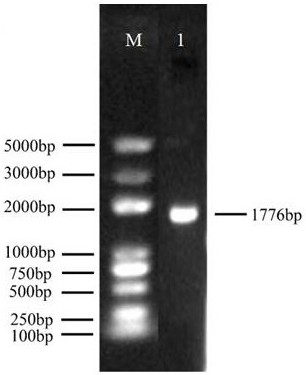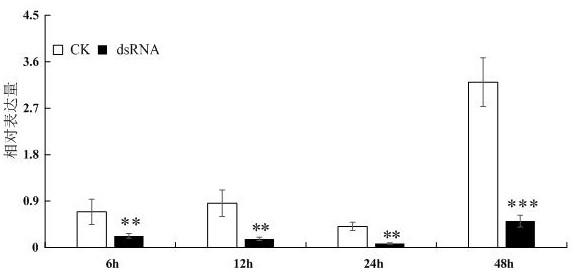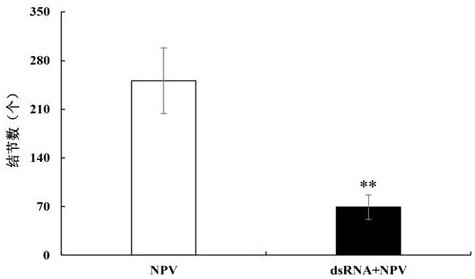Lepidoptera insect Hpx12 gene and application
A Lepidoptera insect and gene technology, applied in the field of genetic engineering, can solve the problems of ecological deterioration, insecticide resistance, etc.
- Summary
- Abstract
- Description
- Claims
- Application Information
AI Technical Summary
Problems solved by technology
Method used
Image
Examples
Embodiment 1
[0038] Hpx12 gene cloning
[0039] (1) According to Anopheles Hpx12 Gene (Gen Bank accession number (XP_311449) protein sequence, search NCBI database to obtain homologous gene in silkworm Hpx12 sequence.
[0040] Regulatory genes of the innate immune response in lepidopteran insects Hpx12 The nucleotide sequence of is shown in SEQ ID NO.1.
[0041]Use this sequence to design gene cloning primer ID No.4 - SEQ ID No.5;
[0042] Forward primer: 5'-CG GGATCC GTTCGCTATGAATCGTTTTC-3'; SEQ ID No. 4;
[0043] Reverse primer: 5'-GGG TTCGAA TTAGTTGCAGCTTTAAAATCATTAA-3'; SEQ ID No. 5.
[0044] B. Extract the whole silkworm RNA of silkworm, and reverse transcribe to obtain the first-strand cDNA;
[0045] C. According to Hpx12 For the gene sequence, use primers SEQ ID No.4 - SEQ ID No.5, and use the first-strand cDNA obtained by reverse transcription as a template for PCR amplification. TransStart high-fidelity amplification enzyme reaction system is selected, and the total vo...
Embodiment 2
[0048] Lepidoptera Hpx12 Synthesis and microinjection of gene dsRNA
[0049] The Lepidoptera insect obtained by cloning according to Example 1 Hpx12 The full-length sequence SEQ ID NO.1 in the gene, designed Hpx12 The ds RNA of the gene is synthesized by in vitro transcription reagents, and the ds RNA sequence is SEQ ID No.3. Specifically, the primers SEQ ID No.6-SEQ ID No. are designed through the RiboMAX Large Scale RNA Production System-T7 kit. 7;
[0050] Forward primer: 5'-GTAATACGACTCACTATAGGGAGAGTTCGCTAT
[0051] GAATCGTTTTC-3'; SEQ ID No. 6;
[0052] Reverse primer: 5'- GTAATACGACTCACTATAGGGAGATTAGTTGCAGCTT
[0053] TAAAATCATTAA-3'; SEQ ID No. 7.
[0054] Bombyx mori larvae of 5 instar and 2 days old with uniform size and health status were selected, and dsGFP-injected control group and dsHpx12-injected experimental group were set up. Before injection, silkworm larvae were anesthetized on ice, and then dsRNA synthesized in vitro was injected into In the body cav...
Embodiment 3
[0057] Lepidoptera Hpx12 The dsRNA of the gene will inhibit the innate immune response of the worm and increase the susceptibility of the worm to pathogens
[0058] Use 75% ethanol to disinfect the surface of the 5th instar and 3-day-old larvae of the silkworm. Inject 2ml of BmNPV into the blood cavity of silkworms injected with dsRNA with a micro-syringe. After standing at 25°C for 2h, the melanin and dark nodules were counted under a microscope with a magnification of 50 times. Control insects were injected with only 2 ml of BmNPV. Each test method was repeated three times. image 3 . Depend on image 3 It can be seen that compared with the control group, the number of nodules in the treatment group injected with dsRNA was significantly reduced, indicating that Lepidoptera insects Hpx12 After the expression of the gene was suppressed, the immunity of the silkworm was greatly reduced.
[0059] Fluorescent quantitative PCR was used to detect the expression of antimicrob...
PUM
 Login to View More
Login to View More Abstract
Description
Claims
Application Information
 Login to View More
Login to View More - R&D
- Intellectual Property
- Life Sciences
- Materials
- Tech Scout
- Unparalleled Data Quality
- Higher Quality Content
- 60% Fewer Hallucinations
Browse by: Latest US Patents, China's latest patents, Technical Efficacy Thesaurus, Application Domain, Technology Topic, Popular Technical Reports.
© 2025 PatSnap. All rights reserved.Legal|Privacy policy|Modern Slavery Act Transparency Statement|Sitemap|About US| Contact US: help@patsnap.com



